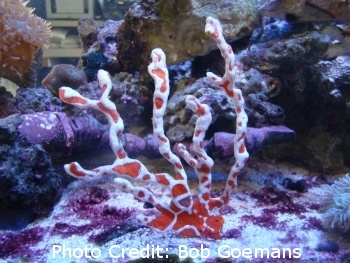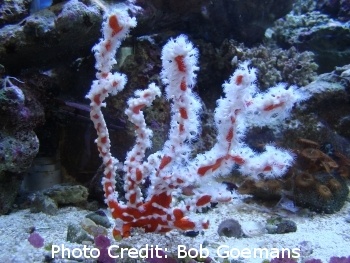
By Bob Goemans

Likely Reef Tank Suitable
Likely Fish-Only Tank Suitable
Range: Western Pacific Ocean
Natural Environment: Inhabits reef slope areas where current is swift.
General Husbandry: Rarely seen in the trade.
Sometimes found encrusted with a white zoanthid, possibly Epizoanthus cf. scotinus or E. cf. stellaris, and then appropriately called the Candy Cane Sponge. The species in the photograph is said to hail from Australian waters, and want to thank the noted British marine biologist and diver Vincent B. Hargreaves Ph.D. (Doctorate in Marine Biology with a double major in Ichthyology, and Marine Invertebrate Zoology) for help in identifying the animal. And as he say's, "The problem here is the classification of the genera Parazoanthus and Epizoanthus is not, at the moment well defined There is much, in fact, that we do not know about these cnidarian creatures, and the current knowledge of the distribution of many is sparse and should not be viewed as an exact science. Future research may very well prove some species are far more widespread than is currently known. For now, until there is further proof saying otherwise, it could well be either species."
Eye-catching would be an understatement, but its zoanthid polyps must be coaxed out if not extended, and fed meaty foods several times daily if it's to succeed in aquariums. And as with almost all sponges, they are better located in nutrient rich surroundings, low light, and impacted by at least moderate water currents.
Unfortunately heavy feeding sometimes results in unwanted algae growths, therefore, increase filtration measures should be taken shortly after feedings if wanting to maintain most sponges in a healthy condition.
Taxonomy:
Kingdom: Animalia
Phylum: Porifera
Class: Demospongiae
Subclass: Heteroscleromorpha
Order: Agelasida
Family: Agelasidae
Genus: Agelas
FYI: When purchasing new specimens, they should be bagged under water, i.e., never lifted out of the water. Nor should any air or oxygen be added to the bag, as it may become trapped in the animal's tissue while being transported and lead to its early demise.
They are not too sensitive to temperature changes, yet sudden changes in salinity may have drastic effects.
New specimens should not contain any gray or white tissue, which is generally a sign of dying or dead tissue. However, it is possible to cut that section out, of course under water.
Experience Level: Intermediate
Diet: Filter feeder
Aquarium Environment: Reef or fish-only aquarium
Coral Safe: Yes
Fish Safe: Yes
Invertebrate Safe: Yes
Acclimation Time: Sensitive to specific gravity/salinity changes, therefore be sure to adjust the bag's water to that of the aquarium in which it will be placed by slowly adding small amounts of aquarium water to the bag every few minutes. In most cases, this process should take at least 15 minutes.
Aquarium Hardiness: Challenging
Temperature Range: 72 - 83°F (22 - 28°C)
Minimum Tank Size: 50 gallons
Water Movement: WM 2 - 3
Specific Gravity: 1.023 - 1.025
pH: 8.0 - 8.4

